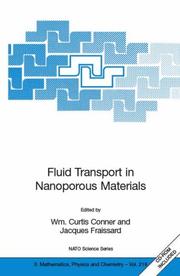| Listing 1 - 4 of 4 |
Sort by
|
Digital
ISBN: 9781402043826 Year: 2006 Publisher: Dordrecht Springer
Abstract | Keywords | Export | Availability | Bookmark
 Loading...
Loading...Choose an application
- Reference Manager
- EndNote
- RefWorks (Direct export to RefWorks)
Classical mechanics. Field theory --- Thermodynamics --- Physicochemistry --- Macromolecules --- Chemistry --- Water supply. Water treatment. Water pollution --- Engineering sciences. Technology --- Computer. Automation --- thermodynamica --- BIT (biochemische ingenieurstechnieken) --- chemie --- informatica --- waterverontreiniging --- ingenieurswetenschappen --- mechanica --- polymeren --- fysicochemie

ISBN: 9781402043789 9781402043826 Year: 2006 Publisher: Dordrecht Springer
Abstract | Keywords | Export | Availability | Bookmark
 Loading...
Loading...Choose an application
- Reference Manager
- EndNote
- RefWorks (Direct export to RefWorks)
The last several years have seen a dramatic increase in the synthesis of new nanoporous materials. The most promising include molecular sieves which are being developed as inorganic or polymeric systems with 0. 3-30nm in pore dimensions. These nanoporous solids have a broad spectrum of applications in chemical and biochemical processes. The unique applications of molecular sieves are based on their sorption and transport selectivity. Yet, the transport processes in nanoporous systems are not understood well. At the same time, the theoretical capabilities have increased exponentially catalyzed by increases in computational capabilities. The interactions between a diffusing species and the host solid are being studied with increasing details and realism. Further, in situ experimental techniques have been developed which give an understanding of the interactions between diffusing species and nanoporous solids that was not available even a few years ago. The time was ripe to bring together these areas of common interest and study to understand what is known and what has yet to be determined concerning transport in nanoporous solids. Molecular sieves are playing an increasing role in a broad range of industrial petrochemical and biological processes. These include shape-selective separations and catalysis as well as sensors and drug delivery. Molecular sieves are made from inorganic as well as organic solids, e. g. , polymers. They can be employed in packed beds, as membranes and as barrier materials. Initially, the applications of molecular sieves were dominated by the use of zeolites.
Porous materials --- Fluid dynamics --- Congresses

ISBN: 9781402043789 Year: 2006 Publisher: Brussels Dordrecht Nato Public Diplomacy Division Springer
Abstract | Keywords | Export | Availability | Bookmark
 Loading...
Loading...Choose an application
- Reference Manager
- EndNote
- RefWorks (Direct export to RefWorks)
Porous materials --- Fluid dynamics --- Congresses

ISBN: 1402043783 1402043805 1402043821 9786610716357 1280716355 Year: 2006 Volume: 219 Publisher: Dordrecht, The Netherlands : Springer in cooperation with NATO Public Diplomacy Division,
Abstract | Keywords | Export | Availability | Bookmark
 Loading...
Loading...Choose an application
- Reference Manager
- EndNote
- RefWorks (Direct export to RefWorks)
The last several years have seen a dramatic increase in the synthesis of new nanoporous materials. The most promising include molecular sieves which are being developed as inorganic or polymeric systems with 0. 3-30nm in pore dimensions. These nanoporous solids have a broad spectrum of applications in chemical and biochemical processes. The unique applications of molecular sieves are based on their sorption and transport selectivity. Yet, the transport processes in nanoporous systems are not understood well. At the same time, the theoretical capabilities have increased exponentially catalyzed by increases in computational capabilities. The interactions between a diffusing species and the host solid are being studied with increasing details and realism. Further, in situ experimental techniques have been developed which give an understanding of the interactions between diffusing species and nanoporous solids that was not available even a few years ago. The time was ripe to bring together these areas of common interest and study to understand what is known and what has yet to be determined concerning transport in nanoporous solids. Molecular sieves are playing an increasing role in a broad range of industrial petrochemical and biological processes. These include shape-selective separations and catalysis as well as sensors and drug delivery. Molecular sieves are made from inorganic as well as organic solids, e. g. , polymers. They can be employed in packed beds, as membranes and as barrier materials. Initially, the applications of molecular sieves were dominated by the use of zeolites.
Porous materials --- Matériaux poreux --- Fluid dynamics --- Congresses. --- Fluides, Dynamique des --- Congrès --- Porous materials. --- Chemical & Materials Engineering --- Engineering & Applied Sciences --- Chemical Engineering --- Materials Science --- Fluid dynamics. --- Matériaux poreux --- Congrès --- EPUB-LIV-FT LIVCHIMI SPRINGER-B --- Porous media --- Materials science. --- Physical chemistry. --- Polymers. --- Chemistry, Physical and theoretical. --- Chemical engineering. --- Continuum physics. --- Materials Science. --- Materials Science, general. --- Industrial Chemistry/Chemical Engineering. --- Physical Chemistry. --- Polymer Sciences. --- Theoretical and Computational Chemistry. --- Classical Continuum Physics. --- Dynamics --- Fluid mechanics --- Materials --- Porosity --- Materials. --- Chemistry, Physical organic. --- Chemistry. --- Classical and Continuum Physics. --- Physical sciences --- Polymere --- Polymeride --- Polymers and polymerization --- Macromolecules --- Chemistry, Physical organic --- Chemistry, Organic --- Chemistry, Physical and theoretical --- Chemistry, Industrial --- Engineering, Chemical --- Industrial chemistry --- Engineering --- Chemistry, Technical --- Metallurgy --- Engineering materials --- Industrial materials --- Engineering design --- Manufacturing processes --- Polymers . --- Classical field theory --- Continuum physics --- Physics --- Continuum mechanics --- Chemistry, Theoretical --- Physical chemistry --- Theoretical chemistry --- Chemistry --- Material science --- Fluid transport --- Nanoporous materials
| Listing 1 - 4 of 4 |
Sort by
|

 Search
Search Feedback
Feedback About UniCat
About UniCat  Help
Help News
News